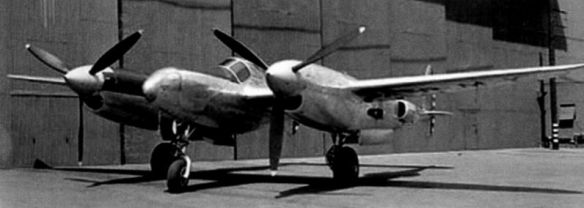Bearing a close resemblance to the P-38, the P-49 was a high-performance warplane with good fighting qualities. The requirement for this long-range aircraft never materialised as the P-51D proved a superior escort fighter when fitted with drop tanks.
The Lockheed XP-49, its designation seemingly out of sequence in that it was a conception of pre-war years, was designed in 1939 with the ambitious goal of attaining 473mph (761.2km/h) in level flight at 15,000ft 14572m). The XP-49 would have been a veritable flying arsenal in its day as it was to be armed with two 20-mm cannon and four 0.5-in (12.7-mm) machine-guns. It was rigorously and exhaustively tested at Burbank, California, and Wright Field, Ohio, and the XP-49 was denied production status because of an engine substitution and the appearance of the Thunderbolt and Mustang.
The XP-49 was an outgrowth of the P-38 Lightning but in most respects was an entirely new design by the Lockheed-Burbank fighter team under H. L. Hibbard and Clarence (Kelly) Johnson. Ordered by the US Army on 3 August 1939 to meet a twin-engine fighter requirement (which also produced the Grumman XP-50) the sole XP-49 140-3055) was expected to attain unprecedented performance by mating the Lightning’s familiar twin-boom layout with two 2,300-hp (1715.1-kW) Pratt & Whitney X-1800 24-cylinder inline engines.
When plans to develop the powerplant proved too ambitious, twin 1,350-hp (1006.7-kW) Continental XIV-1430-1 engines had to be substituted, reducing speed to a still impressive 458mph (737.1km/h), although this was reached because the test ship lacked the added weight of protective armour which would have been fitted on a production variant. “We still felt we had a winner, says a Lockheed engineer. ”We had a roomy, pressurised cabin, good handling characteristics and, eventually, good maneuverability.” US Army planners saw the XP-49 as a possible ‘convoy fighter’ able to escort bombers on deep penetration raids. It might have been accorded higher priority had England been lost as a base from which to mount the air assault on the Third Reich.
The XP-49 first flew 11 November 1942 at Burbank, apparently with Milo Burcham at the controls. When it became necessary to increase the vertical fin area to improve yaw characteristics, the result was an unusual set of markings: Army directives called for 13 alternating red and white horizontal stripes on the rudder, symbolic of the original 13 American colonies. When the tail was heightened, painters simply added non-regulation extra stripes.
At Burbank, the XP-49 survived a crash-landing caused by hydraulic failure, was repaired, and was ferried to Wright Field, Ohio, on 25 June 1943. Though it was a clear improvement over the P-38, able to “fly rings around the Lightning” in the words of one pilot, minor but troublesome fuel leakage problems led to XP-49 tests being discontinued and the airframe being scrapped, just when Mustangs with long-range drop tanks were appearing over Berlin. The ‘convoy fighter’ concept was studied later with the Lockheed XP-58 but never produced an operational aircraft.
Specifications (XP-49)
General characteristics
Crew: One
Length: 40 ft 1 in (12.2 m)
Wingspan: 52 ft (15.8 m)
Height: 9 ft 10 in (3.0 m)
Wing area: 327.5 ft² (30 m²)
Empty weight: 15,410 lb (6990 kg)
Loaded weight: 18,750 lb (8505 kg)
Powerplant: 2 × Continental XI-1430-1 inverted V-12s, 1,600 hp (1,193 kW) each
Performance
Maximum speed: 406 mph (653 km/h) 15,000 ft (4,570 m)
Range: 679 mi (1,093 km)
Rate of climb: 3,300 ft/min (16.8 m/s)
Armament
2 × 20 mm (.79 in) cannons
4 × 0.5 in (12.7 mm) machine guns
